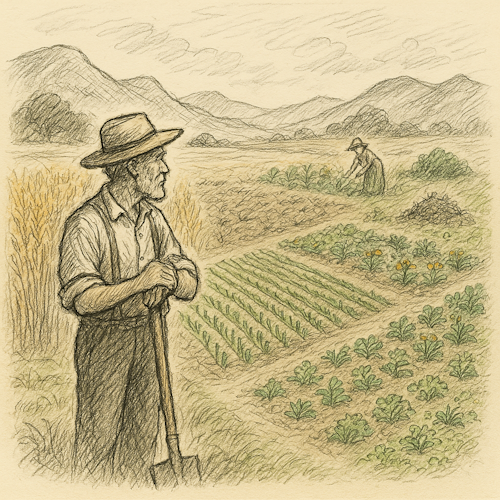The Agile Farmer
Illustrates Sustainable Pace, Emergent Design, Respect for Natural Rhythm
The Agile Farmer is a parable about the value of small, intentional change and the power of feedback loops. It's a story meant for Scrum Masters, Product Owners, and Agile Coaches who are guiding teams toward sustainable agility, not speed for speed's sake.

Once upon a time, in a quiet valley bordered by rugged hills, lived a farmer named Eli. He had inherited his family's land, which had once flourished with crops, but in recent years had grown sparse and tired. Determined to restore it, Eli did what his ancestors had always done: he planted a large field of wheat, using the same tools and the same routines.
The first season, the crop was weak. Rain had come late, weeds had taken over, and pests ruined the yield. Undeterred, Eli tried again, just harder this time. He worked longer days and poured more money into fertilizer and equipment.
The second season was no better.
Frustrated, Eli visited a neighboring farm that always seemed to thrive. There, he met Mara, a soft-spoken farmer with thriving rows of vegetables, herbs, and even flowers. Her fields looked nothing like Eli's vast monotone acres. Curious, he asked, “What's your secret?”
Mara smiled. “I change something every season. A new seed, a different spacing, a tweak to irrigation. I test a little, listen a lot.”
Eli frowned. “But how do you know what works?”
“I don't,” she replied. “Until I try. I pay attention to the soil, the weather, the yield. I inspect, adapt, and move on. Small steps, season after season.”
Eli returned home with a different idea. Instead of planting all wheat again, he split his field. One section stayed the same. The others, he experimented with, cover crops, new grains, drip irrigation, and even a compost heap.
By the end of the season, some parts failed. But others flourished.
In time, Eli became known for a farm that not only recovered, but outpaced the others. Not through massive change, but through measured, intentional growth. He stopped asking, "How can I fix everything?" and started asking, "What can I learn next?"
Lessons Learned
Feedback Beats Prediction
Eli's instinct was to stick with tradition and double down when things didn't work. But predictability failed him. Mara's approach, observe, adjust, learn, illustrates the essence of empiricism. Agile teams gain the most when they reduce reliance on assumptions and prioritize fast feedback through iterative cycles.
Small Experiments Lead to Lasting Change
By dividing his land into test plots, Eli could safely explore options without risking the whole season. Agile teams do the same with MVPs, spikes, prototypes, and pilot programs. Incremental experimentation builds momentum and reduces fear of failure.
Waste Comes From Doing Too Much, Too Fast
Eli's early efforts mirrored many product teams: scaling effort before understanding the root problem. When we optimize for speed without clarity, we increase rework, technical debt, and fatigue. Slowing down to validate assumptions is often the fastest path forward.
Conditions Change, So Must We
Eli's turning point came when he stopped treating the farm as static. Agile recognizes that context, like user needs, market conditions, or team capacity, changes constantly. Teams that inspect and adapt frequently can respond with resilience instead of reacting with panic.
Curiosity Creates Capability
Mara's strength wasn't superior tools or more resources. It was curiosity. Eli's shift from control to inquiry unlocked innovation. In Agile teams, the same transformation occurs when we shift from “deliver faster” to “learn smarter”.
Reflection Multiplies Results
Mara didn't change everything at once. She paid attention, season after season. This mirrors the value of retrospectives and continuous improvement in Agile environments. Learning compounds when teams pause to reflect, intentionally and regularly.
Coaching Tips
- Use this parable to reframe burnout: If your team is tired of "trying harder," help them reflect on trying differently. Use the story to introduce sustainable pace and reflective practice.
- Encourage Sprint Experiments: Just like Mara's test plots, teams can carve out small areas to explore new approaches, tech spikes, or process tweaks.
- Link to Empirical Process Control: The Inspect-Adapt cycle is foundational to Scrum. This story gives it a concrete, emotional hook.
Sustainable agility isn't about doing more. It's about learning faster. Like Eli, teams don't need to bet the farm. They need to pay attention, experiment thoughtfully, and let small wins accumulate.
The Agile mindset grows best when it's tended like a living system, not pushed like a machine.


